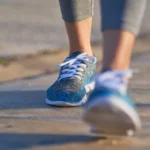Does Walking Build Muscle?
Since walking is a low-impact form of movement, it likely won’t give you the larger muscles you’d get from lifting heavy weights at the gym, for example. But upping the intensity, pace, frequency, and resistance of your walks can help stimulate muscle growth and increase lean muscle mass.
“Walking primarily improves cardiovascular health and endurance, but it can also contribute to muscle tone, especially in the legs and glutes, due to the repetitive motion and resistance against gravity,” Peloton instructor Matty Maggiacomo says.
Although walking won’t drastically increase the size of your muscles on its own, research has proven its many other health benefits, such as boosting your mood, lowering your blood pressure, and reducing your risk for chronic disease.
How Can Walking Build Muscle?
Your fitness level may determine how effective walking is for building muscle. For example, walking stimulates more muscle growth in people who are inactive or lead a sedentary lifestyle than it does in those who already work out regularly. A person who’s already active would need to level up their walking game—adding weights, going faster, etc.—to maximize the muscle-building benefits.
Matty is a fan of incorporating inclines, such as hills or stairs; adding resistance, like ankle weights or a weighted vest; or mixing in intervals of faster walking or jogging. These adjustments all increase the intensity, as does trading smooth, flat terrain for an uneven surface, like a nature trail.
Key Muscles You Engage and Strengthen While Walking
Walking primarily targets your lower body, but it also engages some upper body muscles, like your arms and shoulders, according to physical therapist Lex Gonzales. Below he breaks down the key muscles that you work while walking.
-
Quads: Located in the front of your thighs, your quads extend your knees and stabilize your leg as you step forward.
-
Hamstrings: Located in the back of your thighs, your hamstrings help bend your knees and extend your hips, pulling your legs backward as you walk.
-
Calves: Your calves, which are in the back of your lower legs, propel you forward and help you lift your heels as you walk.
-
Gluteal Muscles: Your glutes are crucial for stabilizing your pelvis and moving your leg back as you stride.
-
Hip Flexors: These muscles lift your thighs as you step forward.
-
Core Muscles (aka your abdominals and lower back): Your core plays a vital role in maintaining your posture and balance while walking.
Different types of walking can influence which muscles you work and how intensely they engage, Gonzales explains. For example, brisk walking and downhill walking rely heavily on your quads to move more quickly or control your descent, he says. Walking uphill can challenge the muscles in the back of your legs, such as your hamstrings, more so than walking on a flat surface.
Power walking, which involves more exaggerated arm swings, and Nordic walking, which incorporates poles, can transform walking into a full body exercise by working your upper body muscles, like your shoulders and arms, he says. And hiking on uneven terrain engages your core, leg muscles, and the smaller stabilizing muscles around your ankles and feet as you try to maintain balance.
“By mixing different types of walking into your routine, you can ensure a well-rounded fitness regimen that enhances muscle tone, strength, and endurance across your body,” Gonzales says.







